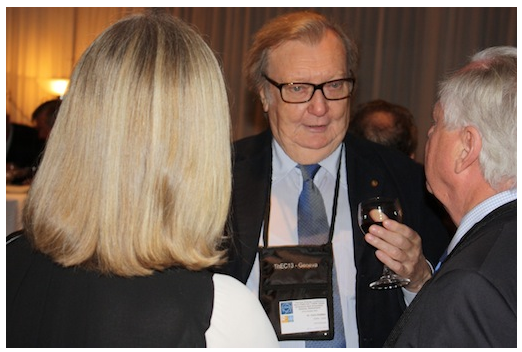GENEVA 2013 –
If nuclear power is to finally overcome public opposition and the post-Fukushima backlash, government and industry must walk away from traditional reactor technology and shift to superior designs that rely on thorium rather than uranium.
So said Nobel Prize winning physicist Carlo Rubbia this morning, addressing the Thorium Energy Conference 2013, held here at the renowned international physics lab CERN.“In order to be vigorously continued, nuclear power must be profoundly modified,” said Rubbia, a former director general of CERN and the co-winner of the 1984 Nobel Prize in Physics.
Rubbia noted that thorium has “absolute pre-eminence” over all fuels including uranium as well as fossil fuels. He said it must become a staple of nuclear because it leaves less long-lived waste than uranium, is far more plentiful, is resistant to weapons proliferation and has a much higher energy content so that reactors will require less of it (see chart below).
RENEWING SHIFT
Rubbia called for a shift toward thorium so that nuclear could play a big role as a low-CO2 energy source, a function that the public tends to associate with renewable energies like wind and solar.“A distinction between renewable and not renewable energy is academic,” said Rubbia, who pointed out that the country most famous for CO2-spewing coal-fired plants, China, could generate the equivalent of its 2007 electricity production – 3.2 trillion kWh – by using an amount of thorium that is just a small percentage of China’s domestic production of rare earth metals. Thorium comes from minerals that also also contain rare earth elements, a class of materials that are vital to the world economy and that China controls.
Energy’s rock solid future. Thorium occurs naturally in minerals like this chunk of monazite from South Africa’s Steenkampskraal mine, on display at the Geneva conference.

Rubbia told a packed audience of thorium and reactor experts that thorium is probably also a superior fuel for reactors known as breeders, which produce more of their own fuel.Thorium supporters differ over the best way to deploy the fuel. Speakers and enthusiasts from around the world are gathered here for four days to compare notes and advocate their own approaches.
SPLIT DIFFERENCE
Rubbia, a particle physicist, prefers a method in which an accelerator coaxes thorium to split by bombarding it with a neutron – a concept known as an “energy amplifier” which he helped conceive.Unlike uranium, thorium is not “fissile.” It requires a method to kick start it, such as the accelerator approach or another technique that mixes it with an isotope of uranium that releases neutrons that in turn excite thorium.Scientists and engineers also differ over whether to burn thorium in conventional reactors or in a number of alternatives such as molten salt reactors or pebble bed reactors, the designs for which date back decades.
Both run at much higher temperatures than today’s reactors and thus support a more efficient generating cycle. They could also serve as a low-CO2 source of industrial process heat, replacing fossil fuels in operations such as cement and steel making.Rubbia co-won the 1984 Nobel for work at CERN leading to the discovery of the W and Z bosons, which are related to the weak force, one of the four fundamental forces of nature along with the strong force, gravity and electromagnetism.
He is currently affiliated with the Gran Sasso National Laboratory in Italy as well as the Institute for Advanced Sustainability Studies in Germany. He was recently named a senator for life in Italy, where he previously ran ENEA, an energy and technology development agency where he promoted solar thermal power.Other speakers followed Rubbia outlining their preferences for thorium and providing updates for thorium reactor initiatives in countries including China, Japan and India. Stay tuned the Weinberg blog for more reports.

The Crown Joule. Thorium has a higher energy content than any other fuel including uranium, even uranium extracted from seawater (sw in the chart), according to this slide from Rubbia’s Geneva presentation.





